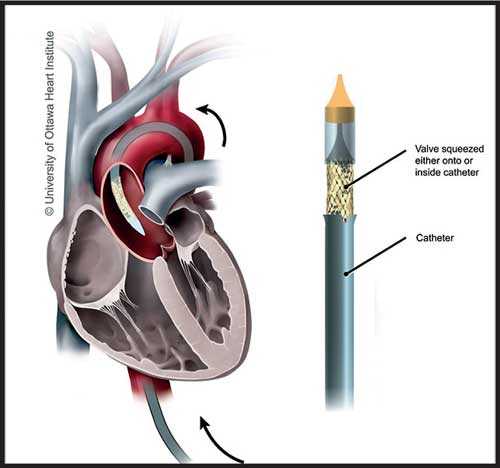Monday Dec 29, 2025
Monday Dec 29, 2025
Thursday, 16 August 2018 00:00 - - {{hitsCtrl.values.hits}}
By Fathima Riznaz Hafi
In the treatment of patients with heart failure, the only way the heart valve could be replaced in the past was through open-heart surgery. In recent years, new procedures have been developed to either repair the heart valve or completely replace the valve without the need to cut the chest open. An increasingly preferred option to conventional procedures is Transcatheter Aortic Valve Implantation (TAVI).
This minimally invasive method which involves a mere 1-cm cut made on the groin area to access a leg artery to advance a bio-prosthetic valve up to the heart via a catheter, offers an attractive option as it comes with lower risks and the heart is not stopped during the procedure.
In this interview with Daily FT, Mount Elizabeth Hospital Singapore Cardiologist Dr. Chiam Toon Lim Paul speaks about TAVI, its benefits and what conditions necessitate it.
The aortic valve and what necessitates TAVI
Dr. Chiam explains, the aortic valve regulates blood flow from the heart to the rest of the body. The valve opens to allow the heart to pump blood to other organs, and closes to prevent blood from flowing backward into the heart. With ageing, the aortic valve may become narrowed, obstructing blood flow from the heart into the aorta and on to the rest of the body, in a condition known as ‘aortic valve stenosis’. When the narrowing becomes severe, patients develop breathlessness, fainting spells and chest discomfort due to a lack of oxygen-rich blood. If left untreated the disease can be deadly, with up to 50% of patients dying within two years.
At this point only a replacement of the valve can save the patient; however, elderly patients are rejected for open-heart surgery, as they fall under the high-risk category. With the introduction of TAVI, they now stand a chance of being saved, as this minimally invasive method has proven to be safer for this group.
What is TAVI?
Emphasising the simplicity and convenience of TAVI, Dr. Chiam explains how it works: “Through this procedure, we are able to replace the aortic valve through a small incision in the groin without the need for open-heart surgery and without the need to actually stop the heart. We use a tissue valve that is prepared in the procedure room and this valve is folded down and put into a small tube, the size of a pen and this is delivered through a hole in the groin to the heart and then replaces the heart valve. We’ve been doing this in Singapore for nearly 10 years now. The patient on whom I performed the first procedure in 2009 is still doing well.”
“Since we first started, the valves used in these procedures have not remained the same – we are now using third generation valves. The devices have become smaller and safer for patients and also the valves have been redesigned to improve the results of this procedure,” he added.
Benefits of TAVI
Unlike open-heart surgery, TAVI is minimally invasive – the chest is not cut open, the heart is not stopped when implanting the transcatheter heart valve, the native aortic valve is not removed and the newly implanted valve does not need to be stitched in place. The procedure can also be done under local anaesthesia. It is done within about one hour and the patient stays only two or three nights in the hospital.
It is a safer treatment option for elderly patients and patients with high surgical risk. As with any heart surgery, TAVI comes with risks but the percentage is significantly low compared to open-heart surgery and other treatment. “Nowadays with the current generation valves and with the current way that we assess patients for this procedure, the risk of the procedure to replace the heart valve is only 1-2%; that includes the risk of stroke and death; so the risk is actually really low right now,” says Dr. Chiam.
How extensive is its usage?
With technological breakthroughs bringing about various options, patients may be at a loss when deciding what they need or under what conditions TAVI may be used. A cardiologist would be the best guide here so we asked Dr. Chiam, what about new-borns? Can TAVI be used for children who were born with heart conditions? Dr. Chiam says, “Most of the children who are born with heart conditions, are born with holes in the hearts. It is very rare to be born with a valve that is severely narrow. Usually it comes together where with a hole in the heart there are many problems.
“So TAVI is not for this group of patients – because they need surgery to repair these holes. We are not plugging holes – we are changing the valve. All these problems that we see with valves are usually in the adult population and especially in the elderly population; so it’s a very different group of patients we are dealing with.”
As for young adults – in their 20s and 30s, he said, “Again, in that age group, we don’t see the valve disease as we know it, because most of the valve diseases are degenerative diseases – it takes time to degenerate (wear and tear). In the young adults, again, the problems that we see are probably related to something that was missed in childhood; for example, holes in the heart that were missed; or they may have had surgery for holes in the heart at a young age and some of these surgical tubes have become worn out and they need a valve replacement.
“So yes, for some of these young patients, there is also a valve that can be put in from the groin but it’s quite different from TAVI; this is a pulmonary valve we are talking about and it is a totally separate valve from the aortic valve that we do for adults; similar in concept but the design of the valve and the way we do it is quite different.”
Other uses for TAVI
“Although the TAVI valve design is for the aortic valve, it can also be used for other purposes, such as in patients with previous heart surgery. If they have a tissue valve previously done – let’s say they had open-heart surgery 10 years ago and had an aortic valve replaced, and now this tissue valve – because it’s an animal tissue, wears out (usually it lasts an average of 10 years; we see many patients now with these valves, who reach 10 years and the valve becomes degenerated again); and if they were to go for another open heart surgery to change the valve, it will be their second surgery to split the chest open; and a second open heart surgery is always a much higher risk than the first one.
“For these patients, now TAVI has become a very attractive option because we don’t need to open the chest – we just go through the groin and put the valve inside. And using this same concept, we can put TAVI valves into almost any other valve in the body that has been changed with the tissue valve,” he said.
Advanced management of heart failure patients
Singapore’s advanced management of heart failure patients produces high success rates, making it a safe and secure place to receive treatment such as TAVI. Presently there are three centres in Singapore that perform TAVI – two in the government sector and one in the private sector. Dr. Chiam is the only doctor in Singapore’s private sector who performs TAVI. For more information on TAVI or for a consultation with Dr. Chiam, contact Parkway’s local representatives, Parkway Patient Assistance Centre on: 0112809000.